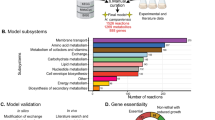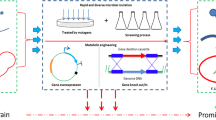Abstract
Engineering d-lactic acid dehydrogenases for higher activity on various 2-oxo acids is important for the synthesis of 2-hydroxy acids that can be utilized in a wide range of industrial fields including the production of biopolymers, pharmaceuticals, and cosmetic compounds. Although there are many d-lactate dehydrogenases (d-LDH) available from a diverse range of sources, there is a lack of biocatalysts with high activities for 2-oxo acids with large functional group at C3. In this study, the d-LDH from Pediococcus acidilactici was rationally designed and further engineered by controlling the intermolecular interactions between substrates and the surrounding residues via analysis of the active site structure of d-LDH. As a result, Y51L mutant with the catalytic efficiency on phenylpyruvate of 2200 s−1 mM−1 and Y51F mutant on 2-oxobutryate and 3-methyl-2-oxobutyrate of 37.2 and 23.2 s−1 mM−1 were found, which were 138-, 8.5-, and 26-fold increases than the wild type on the substrates, respectively. Structural analysis revealed that the distance and the nature of the interactions between the side chain of residue 51 and the substrate C3 substituent group significantly affected the kinetic parameters. Bioconversion of phenyllactate as a practical example of production of the 2-hydroxy acids was investigated, and the Y51F mutant presented the highest productivity in in vitro conversion of D-PLA.






Similar content being viewed by others
References
Taguchi, H., & Ohta, T. (1991). D-lactate dehydrogenase is a member of the D-isomer-specific 2-hydroxyacid dehydrogenase family. Cloning, sequencing, and expression in Escherichia coli of the D-lactate dehydrogenase gene of Lactobacillus plantarum. The Journal of Biological Chemistry, 266(19), 12588–12594.
Kutzenko, A. S., Lamzin, V. S., & Popov, V. O. (1998). Conserved supersecondary structural motif in NAD-dependent dehydrogenases. FEBS Letters, 423(1), 105–109.
Södergård, A., & Stolt, M. (2002). Properties of lactic acid based polymers and their correlation with composition. Progress in Polymer Science, 27(6), 1123–1163.
Tsuji, H., & Okumura, A. (2010). Polymer Journal, 43, 317.
Cheong, S., Clomburg, J. M., & Gonzalez, R. (2018). A synthetic pathway for the production of 2-hydroxyisovaleric acid in Escherichia coli. Journal of Industrial Microbiology & Biotechnology, 45(7), 579–588.
Fujita, T., Nguyen, H. D., Ito, T., Zhou, S., Osada, L., Tateyama, S., Kaneko, T., & Takaya, N. (2013). Microbial monomers custom-synthesized to build true bio-derived aromatic polymers. Applied Microbiology and Biotechnology, 97(20), 8887–8894.
Lavermicocca, P., Valerio, F., & Visconti, A. (2003). Antifungal activity of phenyllactic acid against molds isolated from bakery products. Applied and Environmental Microbiology, 69(1), 634–640.
Chaudhari, S. S., & Gokhale, D. V. (2016). Journal of Bacteriology & Mycology, 2, 121–125.
Tokuda, C., Ishikura, Y., Shigematsu, M., Mutoh, H., Tsuzuki, S., Nakahira, Y., Tamura, Y., Shinoda, T., Arai, K., Takahashi, O., & Taguchi, H. (2003). Conversion of Lactobacillus pentosus d-lactate dehydrogenase to a d-hydroxyisocaproate dehydrogenase through a single amino acid replacement. Journal of Bacteriology, 185(16), 5023–5026.
Zhu, Y., Hu, F., Wang, L., & Qi, B. (2015). Enhancement of phenyllactic acid biosynthesis by recognition site replacement of D-lactate dehydrogenase from Lactobacillus pentosus. Biotechnology Letters, 37(6), 1233–1241.
Ishikura, Y., Tsuzuki, S., Takahashi, O., Tokuda, C., Nakanishi, R., Shinoda, T., & Taguchi, H. (2005). Recognition site for the side chain of 2-ketoacid substrate in D-lactate dehydrogenase. Journal of Biochemistry, 138(6), 741–749.
Zheng, Z., Sheng, B., Gao, C., Zhang, H., Qin, T., Ma, C., & Xu, P. (2013). Highly stereoselective biosynthesis of (R)-α-hydroxy carboxylic acids through rationally re-designed mutation of d-lactate dehydrogenase. Scientific Reports, 3(1), 3401.
Mu, W., Yu, S., Jiang, B., & Li, X. (2012). Characterization of d-lactate dehydrogenase from Pediococcus acidilactici that converts phenylpyruvic acid into phenyllactic acid. Biotechnology Letters, 34(5), 907–911.
Yu, S., Jiang, H., Jiang, B., & Mu, W. (2012). Characterization of D-lactate dehydrogenase producing D-3-phenyllactic acid from Pediococcus pentosaceus. Bioscience Biotechnology and Biochemistry, 76(4), 853–855.
Steiner, K., & Schwab, H. (2012). Recent advances in rational approaches for enzyme engineering. Computational and Structural Biotechnology Journal, 2(3), e201209010.
Yeon, Y. J., Park, H. Y., & Yoo, Y. J. (2015). Engineering substrate specificity of succinic semialdehyde reductase (AKR7A5) for efficient conversion of levulinic acid to 4-hydroxyvaleric acid. Journal of Biotechnology, 210, 38–43.
Yeon, Y. J., Park, H. Y., & Yoo, Y. J. (2013). Enzymatic reduction of levulinic acid by engineering the substrate specificity of 3-hydroxybutyrate dehydrogenase. Bioresource Technology, 134, 377–380.
Razeto, A., Kochhar, S., Hottinger, H., Dauter, M., Wilson, K. S., & Lamzin, V. S. (2002). Domain closure, substrate specificity and catalysis of d-lactate dehydrogenase from Lactobacillus bulgaricus. Journal of Molecular Biology, 318(1), 109–119.
Antonyuk, S. V., Strange, R. W., Ellis, M. J., Bessho, Y., Kuramitsu, S., Inoue, Y., Yokoyama, S., & Hasnain, S. S. (2009). Structure of D-lactate dehydrogenase from Aquifex aeolicus complexed with NAD+ and lactic acid (or pyruvate). Acta Crystallographica. Section F, Structural Biology and Crystallization Communications, 65(12), 1209–1213.
Hammes-Schiffer, S. (2002). Comparison of hydride, hydrogen atom, and proton-coupled electron transfer reactions. ChemPhysChem., 3(1), 33–42.
Wang, M., Zhu, L., Xu, X., Wang, L., Yin, R., & Yu, B. (2016). Efficient production of enantiomerically pure d-phenyllactate from phenylpyruvate by structure-guided design of an engineered d-lactate dehydrogenase. Applied Microbiology and Biotechnology, 100(17), 7471–7478.
Dengler, U., Niefind, K., Kiess, M., & Schomburg, D. (1997). Crystal structure of a ternary complex of d -2-hydroxyisocaproate dehydrogenase from Lactobacillus casei , NAD + and 2-oxoisocaproate at 1.9 Å resolution 1 1Edited by R. Huber. Journal of Molecular Biology, 267(3), 640–660.
Lee, H. S., Park, J., Yoo, Y. J., & Yeon, Y. J. (2019). A novel d-2-hydroxy acid dehydrogenase with high substrate preference for phenylpyruvate originating from lactic acid bacteria: structural analysis on the substrate specificity. Enzyme and Microbial Technology, 125, 37–44.
Altschul, S. F., Madden, T. L., Schaffer, A. A., Zhang, J., Zhang, Z., Miller, W., & Lipman, D. J. (1997). Gapped BLAST and PSI-BLAST: a new generation of protein database search programs. Nucleic Acids Research, 25(17), 3389–3402.
Prime. (2018). Schrödinger Release 2018-4, Schrödinger. New York, NY: LLC.
Lovell, S. C., Davis, I. W., Arendall, W. B., 3rd, De Bakker, P. I., Word, J. M., Prisant, M. G., Richardson, J. S., & Richardson, D. C. (2003). Structure validation by Cα geometry: ϕ, ψ and Cβ deviation. Proteins., 50(3), 437–450.
Pramanik, K., Ghosh, P. K., Ray, S., Sarkar, A., Mitra, S., & Maiti, T. K. (2017). An in silico structural, functional and phylogenetic analysis with three dimensional protein modeling of alkaline phosphatase enzyme of Pseudomonas aeruginosa. Journal, Genetic Engineering & Biotechnology, 15(2), 527–537.
LigPrep. (2018). Schrödinger Release 2018–4, Schrödinger. New York, NY: LLC.
Friesner, R. A., Banks, J. L., Murphy, R. B., Halgren, T. A., Klicic, J. J., Mainz, D. T., Repasky, M. P., Knoll, E. H., Shelley, M., Perry, J. K., Shaw, D. E., Francis, P., & Shenkin, P. S. (2004). Glide: a new approach for rapid, accurate docking and scoring. 1. Method and assessment of docking accuracy. Journal of Medicinal Chemistry, 47(7), 1739–1749.
Halgren, T. A., Murphy, R. B., Friesner, R. A., Beard, H. S., Frye, L. L., Pollard, W. T., & Banks, J. L. (2004). Glide: a new approach for rapid, accurate docking and scoring. 2. Enrichment factors in database screening. Journal of Medicinal Chemistry, 47(7), 1750–1759.
Glide. (2018). Schrödinger Release 2018-4. New York, NY: Schrödinger.
Zheng, L., Baumann, U., & Reymond, J. L. (2004). An efficient one-step site-directed and site-saturation mutagenesis protocol. Nucleic Acids Research, 32(14), e115.
Bradford, M. M. (1976). A rapid and sensitive method for the quantitation of microgram quantities of protein utilizing the principle of protein-dye binding. Analytical Biochemistry, 72(1-2), 248–254.
Tekewe, A., Singh, S., Singh, M., Mohan, U., & Banerjee, U. C. (2008). Development and validation of HPLC method for the resolution of drug intermediates: dl-3-Phenyllactic acid, dl-O-acetyl-3-phenyllactic acid and (±)-mexiletine acetamide enantiomers. Talanta., 75(1), 239–245.
Luthy, R., Bowie, J. U., & Eisenberg, D. (1992). Assessment of protein models with three-dimensional profiles. Nat., 356(6364), 83–85.
Colovos, C., & Yeates, T. O. (1993). Verification of protein structures: patterns of nonbonded atomic interactions. Protein Science, 2(9), 1511–1519.
Pontius, J., Richelle, J., & Wodak, S. J. (1996). Deviations from standard atomic volumes as a quality measure for protein crystal structures. Journal of Molecular Biology, 264(1), 121–136.
Laskowski, R. A., Rullmannn, J. A., Macarthur, M. W., Kaptein, R., & Thornton, J. M. (1996). AQUA and PROCHECK-NMR: programs for checking the quality of protein structures solved by NMR. Journal of Biomolecular NMR, 8(4), 477–486.
Kumar, A., Kumar, S., Kumar, A., Sharma, N., Sharma, M., Pal Singh, K., & Rathore, M. (2017). Proc Natl Acad Sci, India, Sect B Biol Sci, 88, 1539–1548.
Taguchi, H., Ohta, T., & Matsuzawa, H. (1997). Involvement of Glu-264 and Arg-235 in the essential interaction between the catalytic imidazole and substrate for the D-lactate dehydrogenase catalysis. Journal of Biochemistry, 122(4), 802–809.
Furukawa, N., Miyanaga, A., Togawa, M., Nakajima, M., & Taguchi, H. (2014). Diverse allosteric and catalytic functions of tetrameric d-lactate dehydrogenases from three Gram-negative bacteria. AMB Express, 4(1), 76.
Zhadin, N., Gulotta, M., & Callender, R. (2008). Probing the role of dynamics in hydride transfer catalyzed by lactate dehydrogenase. Biophysical Journal, 95(4), 1974–1984.
Sinnokrot, M. O., Valeev, E. F., & Sherrill, C. D. (2002). Estimates of the ab initio limit for π−π interactions: the benzene dimer. Journal of the American Chemical Society, 124(36), 10887–10893.
Funding
This research was supported by the Technology Development Program to Solve Climate Changes of the National Research Foundation (NRF) funded by the Ministry of Science and ICT (Grant Number, 2017M1A2A2087630).
Author information
Authors and Affiliations
Corresponding authors
Ethics declarations
Conflict of Interest
The authors declare that they have no conflicts of interest.
Research Involving Human Participants and/or Animals
This article does not contain any studies with human participants performed by any of the authors.
Additional information
Publisher’s Note
Springer Nature remains neutral with regard to jurisdictional claims in published maps and institutional affiliations.
Electronic Supplementary Material
ESM 1
(DOCX 9031 kb)
Rights and permissions
About this article
Cite this article
Lee, HS., Park, J., Yoo, Y.J. et al. Engineering d-Lactate Dehydrogenase from Pediococcus acidilactici for Improved Activity on 2-Hydroxy Acids with Bulky C3 Functional Group. Appl Biochem Biotechnol 189, 1141–1155 (2019). https://doi.org/10.1007/s12010-019-03053-7
Received:
Accepted:
Published:
Issue Date:
DOI: https://doi.org/10.1007/s12010-019-03053-7




